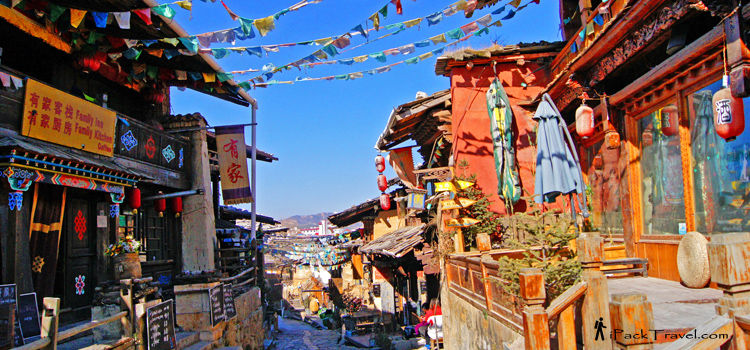China Story 16: Three Ancient Towns of Lijiang (丽江三古镇)
- Rick

- Dec 2, 2017
- 4 min read
Updated: Jul 7, 2020

Sights: Old Town of Lijiang (丽江古城区)
Region: Lijiang Prefecture, Yunnan Province
注:云南.丽江市
Another UNESCO Heritage Site of China, the Old Town of Lijiang actually comprises of three districts of ancient towns, namely, Dayan Ancient Town (大研古镇), Shuhe Ancient Town (束河古镇) and Baisha Ancient Town (白沙古镇). The residents in Lijiang are predominantly the Naxi minority people (纳西族) and Han people.
Most travellers would assume that the three towns are roughly similar and opted to just explore one of them. In this post, you will see that they are characteristically different and accommodate travellers with different paces.
Previously, I was in Shuanglang Town of Dali
Getting from Shuanglang Town to Lijiang
Together with Xiaohan, a Zhuang minority girl from Guangxi, we took the local bus from Shuanglang Town to a road intersection along the Dali-Lijiang highway. Then, we got on a city bus bounded for Lijiang. The bus dropped us right outside Dayan Ancient Town but we took a local bus to Shuhe Ancient Town instead.
Where I Stayed
In Shuhe Ancient Town, we went for the first youth hostel we saw (forgot the name of the hostel) and checked in. Staying in Shuhe Ancient Town would allow us to explore both Dayan Town and Baisha Town using short day trips.
In fact, I was in Lijiang three times on this trip. The first was from Shuanglang Town to Lijiang, then off to Shangri-la for 2 weeks. After returning from Shangri-la, I stayed for a couple of nights in Shuhe Town before heading to Lugu Lake (泸沽湖) near the Yunnan-Sichuan border. I was back for the third time from Lugu Lake but stayed in Dayan Ancient Town before going off to Shaxi Ancient Town (沙溪古镇) on a detour back to Dali Ancient Town.
1. Dayan Ancient Town (大研古镇)
Among the three ancient towns, Dayan Town was the most touristy with hordes of tour groups. To most tourists, Dayan Ancient Town was "Lijiang Ancient City". Most of them will not be shown to the other two old towns by their guides since almost all the commercial functions (hotels, restaurants, shops, etc.) were in Dayan.

The traditional structures of the houses in Dayan were still very well preserved without having hybrids of modern architectures inside the old town — they were all located just outside the old towns.

Yulong (Jade Dragon) Snow Mountain stood in the backdrop of the old town.

The aspiration wind bells were of Dongba culture (东巴文化) of the Naxi minority people. Well-wishers would write their wishes on the wind bells and tied them to the structure provided. Each wind bell carried some Dongba drawings of blessed wishes.

The main streets were always crowded with more shops and restaurants. Cafes and traditional shops could be found in the quieter alleys.



In fact, both Shuhe and Baisha were better places to find out more about the way of life of Naxi minority people and Dongba culture than in Dayan.
2. Shuhe Ancient Town (束河古镇)
Shuhe Ancient Town was more popular with backpackers and free-&-easy Chinese travellers. This old town was more poetic, artistic and scenic. The pace was comparatively slower than Dayan Town. There were no lack of commercial functions here too but tour groups were fewer. The atmosphere was almost similar to Dali Ancient City.
Unlike Dayan Ancient Town, a clear-water river ran through the heart of Shuhe Ancient Town. The water and reflections made the old town much more scenic than Dayan.



The cool water from the steam was used to cool beverages and fresh vegetables. These vegetables were usually eaten raw as thirst-quenching "refreshments" instead of for cooking.

There were many such fun and humorous shops around. However, only those who could understand Chinese would be able to appreciate the humour.

One of places to visit in Shuhe Ancient Town would be the Museum for The Ancient Tea-Horse Trail (茶马古道博物馆) to learn about the important tea trade route from Sichuan and Yunnan to Tibet in ancient China.

The Three Wells was not something unfamiliar — I had seen a similar one in Huangyao Ancient Town in Hezhou, Guangxi. The top well (left) was for drinking, middle well for washing vegetables and bottom well (right) was for laundry.

And the most interesting was the guessing of the Dongba language (or drawings) of the Naxi minority people — Dongba is one of the extremely few minority languages that can be written. The characters depict objects of nature to imply certain things. Try guessing them.

The Dongba drawings on the wall means: "A fast horse will be ridden by human, don't be unhappy. A capable man will be sought by others, don't be hesitant."

It wasn't difficult to guess why I spent more time in Shuhe than Dayan.
3. Baisha Ancient Town (白沙古镇)
Despite being an important commercial town in its long history, Baisha Town was the most laid-back town among the three towns. There were more residential than commercial functions here. Chinese travellers who preferred home stays and getting close to Naxi culture would usually put up in this town.
We took a hike from Shuhe Ancient Town to Baisha Ancient Town and checked out the agricultural landscape with Yulong Snow Mountain less than 10Km away. It was already in winter and all the fields were harvested.

The traditional architectures of the houses were still very well preserved.


Inside the old town were the familiar sights of small steam running in front of the houses.

And Baisha Ancient Town was well-known for its silk embroidery.

Finally, Shangri-La!





Comments